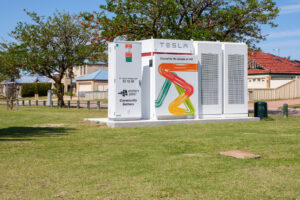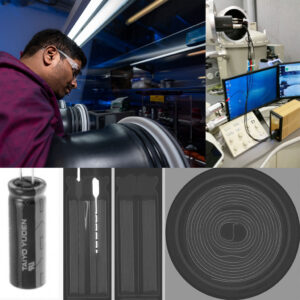There are no current student opportunities.
Past student opportunities
PhD: integrating electric vehicles with buildings and grids
5 September 2022
This project will focus on demonstrating the value of future grid-integrated electric vehicle ecosystems. In particular, managed charging, and bidirectional charging through vehicle-to-home (V2H), vehicle-to-grid (V2G) and vehicle-to-premises (V2P), which are collectively referred to as V2X. Deadline 31 October 2022.

Neighbourhood battery research
16 November 2021
Expressions of interest are now being sought for two neighbourhood battery research initiatives
- Impact of neigbourhood batteries on decarbonisation
- Upgrading the electricity network to support rooftop solar PV energy generation
Suitable candidates will have completed coursework or have equivalent experience in electronics engineering or renewable energy systems for both of the above projects. Deadline: 14 February 2022.

Battery materials, imaging and visualisation
2 July 2021
Expressions of interest are now being sought for the following four positions
- Two PhD scholarships – Battery materials
- One PhD scholarship – X-ray computed tomography of batteries
- One PhD scholarship – In-situ transmission electron microscopy of batteries and battery materials
Find out more information below.

Two PhD scholarships in battery materials
2 July 2021
The ANU Battery Storage and Grid Integration Program and The Research School of Chemistry, ANU, are looking for two talented and motivated PhD students interested in the areas of materials (electrodes and electrolytes) for existing and new battery chemistries, including lithium-ion (Li-ion), sodium-ion (Na-ion), potassium-ion (K-ion) and dual-ion batteries.
The currently dominant Li-ion batteries as well as their sustainable alternatives based on Na, K and dual-ion chemistries are enabled by their electrode and electrolyte materials, which define all the performance characteristics of these batteries. The ANU research group works on the discovery and development of electrode materials and electrolytes that will lead to the improvement of all these battery systems. Cutting-edge materials synthesis, materials characterisation methods and the evaluation in the electrochemical cells, including in-situ methods, are all parts of the battery research undertaken in the group.
The research projects will take place in a brand-new, state-of-the-art Battery Laboratory recently launched by the ANU:
https://bsgip.com/facilities/battery-lab/
For more information on the research projects undertaken by the group, please consult the following pages:
https://chemistry.anu.edu.au/research/groups/glushenkov-group
https://bsgip.com/research/sodium-ion-and-potassium-ion-batteries/
https://bsgip.com/research/dual-ion-batteries/
https://bsgip.com/research/hybrid-energy-storage/
Applicants with a background in chemistry, engineering of physics are encouraged to apply. The minimum requirement is an Honours or Master degree with a sufficient research component and the level of university grades consistent with ANU requirements for postgraduate scholarships and fee waivers.
An Expression of Interest (EOI), consisting of a CV and cover letter should be submitted to Associate Professor Alexey Glushenkov (alexey.glushenkov@anu.edu.au).
Find out more about studying at ANU here.
PhD scholarship in x-ray computed tomography of batteries
2 July 2021
The ANU Battery Storage and Grid Integration Program and The Research School of Chemistry, ANU, are looking for a talented and motivated PhD student interested in the visualisation of batteries and the processes occurring in these electrochemical devices by means of x-ray computed tomography (CT).
The research project will be undertaken using the facilities of the National Laboratory for X-ray Micro Computed Tomography, the ANU Battery Storage and Grid Integration Program (BSGIP) and the ANU Research School of Chemistry (RSC):
https://chemistry.anu.edu.au/research/groups/glushenkov-group
The project will be co-supervised by Associate Professor Alexey Glushenkov (BSGIP and RSC) and Associate Professor Mohammad Saadatfar (CT Lab).
Applicants with a background in physics, engineering or materials science with experience in computer modelling are encouraged to apply. The minimum requirement is an Honours or Master degree with a sufficient research component and the level of university grades consistent with ANU requirements for postgraduate scholarships and fee waivers.
Computer skills in image analysis, numerical modelling and finite element multi-physics simulations as well as coding skills are an advantage. The PhD candidate is expected to work collaboratively within a multi-disciplinary team requiring a high level of communication and scientific writing skills.
An Expression of Interest (EOI), consisting of a CV and cover letter should be submitted to Associate Professor Alexey Glushenkov (alexey.glushenkov@anu.edu.au).
Find out more about studying at ANU here.
PhD scholarship – in-situ transmission electron microscopy of batteries and battery materials
2 July 2021
The ANU Battery Storage and Grid Integration Program and the Research School of Chemistry, ANU, are looking for a talented and motivated PhD student interested in in-situ transmission electron microscopy of batteries.
The research project will be undertaken using the facilities of the ANU Centre for Advanced Microscopy, the Battery Storage and Grid Integration Program (BSGIP) and the Research School of Chemistry (RSC):
https://microscopy.anu.edu.au/
https://chemistry.anu.edu.au/research/groups/glushenkov-group
The researchers at ANU have established an exciting and unique capability of electrochemical experiments in liquid cells inside of transmission electron microscopes (TEM). The available equipment and in-situ holder bring the opportunity to build realistic battery and three-electrode cells with liquid electrolytes and visualise the processes in battery electrode materials and electrolytes in operating batteries by TEM:
https://www.protochips.com/applications/energy-materials/
The team is looking for a motivated PhD student to assist with this work.
Applicants with a background in chemistry, physics, engineering or materials science encouraged to apply. The minimum requirement is an Honours or Master degree with a sufficient research component and the level of university grades consistent with ANU requirements for postgraduate scholarships and fee waivers. Skills in electron microscopy and image analysis are an advantage.
An Expression of Interest (EOI), consisting of a CV and cover letter should be submitted to Associate Professor Alexey Glushenkov (alexey.glushenkov@anu.edu.au).
Find out more about studying at ANU here.
